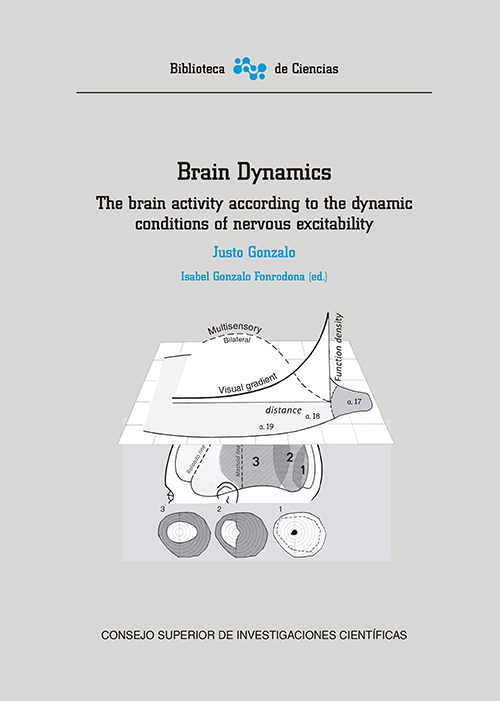
Subjects 
- Archaeology and Prehistory (161)
- Arts and Architecture (240)
- Earth Sciences (95)
- History and Historiography (302)
- History of Science (101)
- Information and Library Sciences (80)
- Life Sciences (170)
- Linguistics and Philology (100)
- Literature and Literary Criticism (134)
- Philosophy and Religion (110)
- Popular Science (258)
- Science and Technology (145)
- Social Sciences (153)
Collections 
Authors 
Send a friend 
Brain dynamics : the brain activity according to the dynamic conditions of nervous excitability. (Volumes 1 and 2, supplements I and II)
  Justo Gonzalo Affiliation: Not available Biography: (Barcelona,1910-Madrid, 1986) graduated in Medicine in Madrid (1933), and specialized in neurology in Austria and Germany (1933-1935) with H. Hoff, O. Pötzl and K. Kleist, funded by the Junta para Ampliación de Estudios (JAE). He worked as a clinical neurologist, and also conducted anatomoclinical research at the Cajal Institute (Madrid 1936-1937). He was assigned as a physician in the Republican front (1937) during the Spanish Civil War (1936-1939), and as a neurologist in a military hospital of Valencia (1938-1939), where he identified peculiar phenomena in some of the war braininjured patients.This was the beginning of a broad and novel research that Gonzalo developed on the human cerebral cortex. The first results were presented to the Consejo Superior de Investigaciones Científicas (CSIC) in 1941, institution to which he was adscribed until his retirement. He was head of the Laboratory of Brain Pathophysiology at the Cajal Institute, in the Faculty of Medicine in Madrid, where he examined a large number of brain-injured subjects, and taught doctoral courses on Brain Pathophysiology (1945-1966) also exposing his research. His two-volume book in Spanish on Brain Dynamics was well received internationally, and awarded by the Real Academia Nacional de Medicina (1950) and the Sociedad Española de Psicología (1958). His whole life was inseparable from study and research, delving into disciplines such as biology, physics, mathematics and philosophy. Isabel Gonzalo Fonrodona (edicion) Affiliation: Universidad Complutense de Madrid (UCM). Facultad de Ciencias Físicas. Complutense University of Madrid (UCM). Physics Faculty. Biography: (Madrid, 1949), PhD in Physics from the Complutense University of Madrid (UCM), is currently professor emeritus at the UCM, in the Optics Department of the Faculty of Physics, where she has developed an extensive teaching and research work in fields such as Optics, Quantum Physics, Molecular Physics and Photonics, publishing her reseach in international journals. She continues her research activity in Quantum Physics and Optics. As connoisseur of Justo Gonzalo’s research, she has also published several works on his research, presenting many of them at international meetings. |
Justo Gonzalo Publication year: 2023 Language: English Subjects: Life Sciences Collection: Biblioteca de Ciencias Free eBook |
Abstract:
The present edition is the first English translation of a large part of Justo Gonzalo’s original work on Brain Dynamics, closely related to current research topics. Some of the phenomena described were observed much later and others are still unknown. In the parts of Vol. 1 (1945) and 2 (1950) the author characterizes, on the basis of brain injuries from the Spanish Civil War, the central syndrome of the cerebral cortex (multisensory and bilateral disorder) caused by a single unilateral parietoocipital lesion. The observed dynamic effects, such as a gradual loss of functions with decreasing stimulus and their recovery by its intensification or by multisensory or motor facilitation, or by iteration, are explained on a physiological basis. The author describes a careful experimental, quantitative analysis of visual and tactile functions, finding a continuity between simple sensations and higher brain functions. He describes for the first time in great detail phenomena such as inverted or tilted vision, some color disorders, reversal of motion, facilitation, etc. Tactile inversion is also described, generalizing the inverted perception in the central syndrome.
Supplement I is the 1952 publication in which the author reports additional cases, and proposes, for the first time, that the specificity of a human brain function is distributed in gradation across the cortex, resulting in brain gradients and a unitary conception of the cortex. Supplement II deals with the concepts of dynamic similarity and allometric scaling power laws applied to the central syndrome, and shows later illustrations by the author.
Bibliographic information
Physical Description : 648 p. : 24 cm
ISBN: 978-84-00-11232-5
eISBN: 978-84-00-11233-2
Publication: Madrid : Consejo Superior de Investigaciones Científicas, 2023
Reference CSIC: 14070
Buy the digital edition atThis eBook is available for free download Buy the print edition at |
Free Downloads |
This book was added to our online catalog on Wednesday 31 January, 2024.







